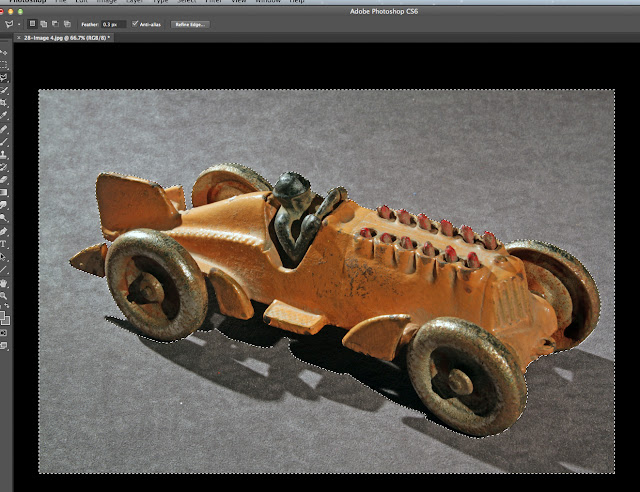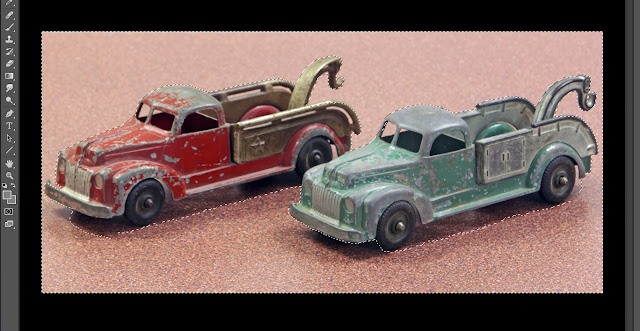Friday, February 22, 2013
Removing a Distracting Background
(Using Photoshop)
Part I
I have another blog about old toys (oldantiquetoys.blogspot.com). I write about old toys, and lately new modern diecast toys. I sometimes ask the people from whom I get permission to use their photos, if I may remove backgrounds, or do some minor photoshop enhancements.
In the last several posts I decided to remove the background altogether, so that the diecast models would show better against a plain white background. I use Photoshop, but it's far from perfect. Everyone uses it and eventually figures out how to get a result. There's no point in complaining, and I refuse to provide feedback. I Once asked for a free copy of PS if I'd do a thorough and exhaustive analysis of PS, and practically got hung on an Adobe PS community, so I stopped that suggestion. Also if you ask a question there, you don;t always get an answer or an answer to quantify the issue to 100% satisfaction.
Because, I'm using PS more and more, you begin to realize just how weak it is in terms of your personal needs. It's still the # 1 program, and I use it because of 2 things. First, we only sued PS in the College, and second, Adobe would give teacher discounts, and I value that. However, once you retire - forget that!
The ease or difficulty of removing a background in PS depends on may factors.
1. A red object on a white background is easy.
2. A multi-coloured item on a multi-coloured background is extremely hard.
3. A soft-lit object on a simple background is easier than a hardly lit item.
4. An object with plenty of shades or tones will be more difficult to separate from the background.
In today's post, I'm going to give a compressed version of what happens. Tomorrow, I'll fill in the steps. What I'll show today works for myself and fast. However, there are 10 more ways in PS of doing the same thing. PS is a packrat, and keeps almost everything since day 1 of its release. So if you have a solution that works for you, and is fast use it!
I'm using a photo of a Doepke 1940's Earth loader. I used to photograph the toys that I sold on e-bay on a grey material,that always reflected red!. Also, As I mentioned, a plain white background presents the item (any item) best when there are no distractions - e.g. a grey background with shadows and folds.
The red colour-cast from my grey material
A larger side-by-side view
I'm going to use the Color Range / Sampled Colors Tools
There are 2 controls for sampling the colours to remove:
1. Fuzziness:
Above, the fuzziness percentage is low. As a result the initial capture will be low.
You'd use a low percentage value to capture just a specific colour, or a small sample from a small area. The opposite would hold true for a larger area.
The "fuzziness" setting set low.
The "fuzziness" setting set high.
The "range" setting set high.
You use the eyedropper to select the colours that you wants. Once that is done, the usual 2 rectangles on the left side of the vertical menu will change from black and white to grey and grey.
Above is a colour-sample that I did.
Here's how the 2 colour-range looks on that menu
Here's how the removal of the grey material looks.
Don;t ask me why Photoshop does this - I have no idea.
What I want is a white background. So I have to place my cursor (mouse) on the left vertical menu and revert the grey/grey squares to the default (standard) black/white rectangles.
The grey is not a total loss, because the screen-capture illustrates the inadequacies of Photoshops "capture". Later, on I'm going to "refine"the capture to capture just the grey background. I would have thought that since PS is based on exact mathematics, a grey shade on the background, and a grey shade on a silver chain or a black track guard would be different - nope!
Tghe resulot presented against a white background - just as bad!
How do I solve this problem?
I use some other "capture tools" to add or remove areas that I want or don't want.
I've pointed the arrows to 2 of these "capture" vehicles, and the brush below will also work.
All the capture tools can function to add or remove content.
Above, the arrow is pointing to the Quick Selection / Magic Brush" Icon - specifically the "Magic Brush" tool. A "+" adds to the capture, while a "-" removes from the capture.
I'll use the - to remove all the "marching ants" from the chain.
AS I mentioned before, PS is far from ideal,and you need lots of trial and error to get it right.
I'm starting this post at the "hard" level". My reason is that every PS book, that I've purchase always presents a 100% excellent solution,but if the "real world" PS simply does not work that well, and that fast for myself.
The + tool above will be used to add the missed black metal wheels to the capture.
What PS did was "capture" the black thinking is was grey!
I've omitted a lot of steps here. I'll present them in the next post.
However, I now have the entire sand or earth loader captured.
If you look closely, I left the grey areas with the captured Doepke toy intact.
They're easier to remove later, with any of the other tools, as they are grey within an orange from - that works easily in PS!
Using any of the capture tools has its limitations. Also, the marching ants or line surrounding the capture, will be "rough". So what you can do is smooth out the lines, as well as widening or narrowing the capture outline.
Here's the Doepke toy removed from the grey material foundation or background.
In the next post, I'll:
1. remove the remaining grey fabric
2. Refine the capture. There will be some grey in the white areas that will not have captured well.
I haven't posted much in the last couple of months because of low readership. However, I do value the few of you who have come by -Thank you.
I've improved my toy site, so please drop by and compare a post 1 year ago to a recent one.
As always,thanks for visiting,
and have a great day, wherever you may be.
Stacey Bindman

















































